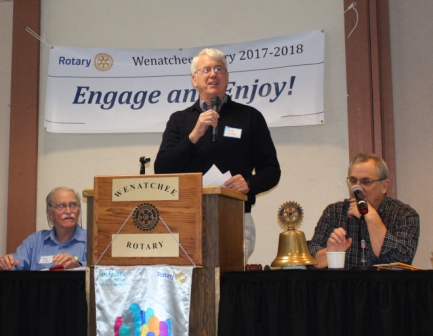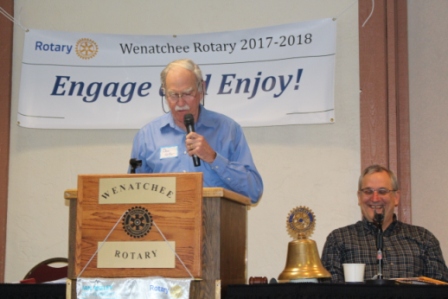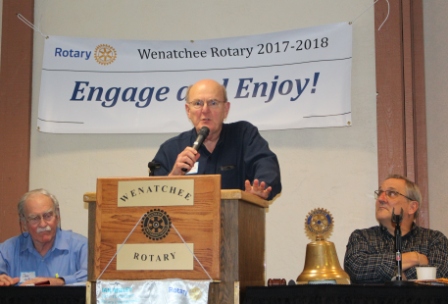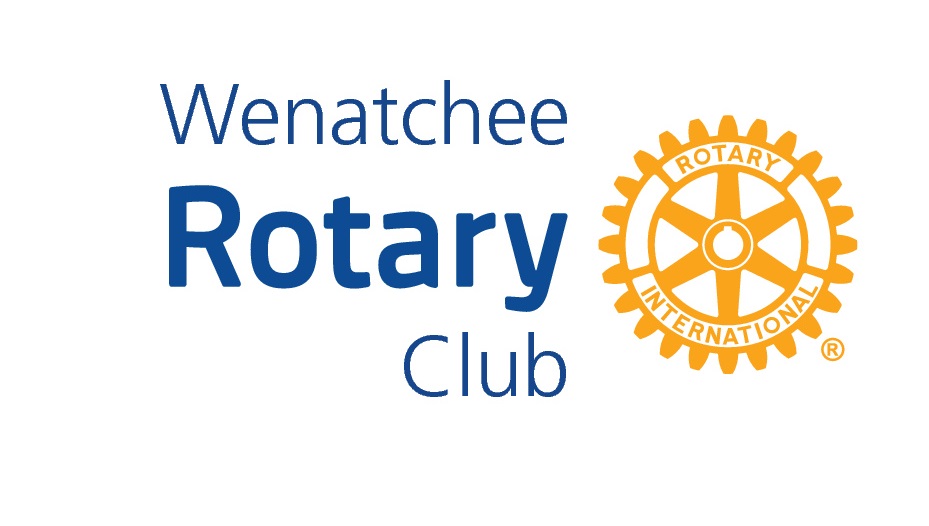Community Foundation with Gil Sparks

Imagine a community where every child has a safe place to call home, every animal is rescued and loved, every family has enough food to eat and a warm bed to sleep, every senior has a comfortable place to age, and every student has a chance to go to college.
If we all Give 10, we don’t have to imagine.
On February 8th, the Community Foundation of North Central Washington will join us to talk about the many ways we can give to support charitable work in our community, and their recently launched “Give 10” campaign to inspire everyone in our region to leave a legacy in the community we love.
Community Philanthropy means we all chip in together. It means every one of us gives something – no matter how big or small – back to the community that gives us so much.
Last year the foundation was able to award about $4 Million to charitable causes that are impacting our community – and that is no small number. But a recent study done by the Community Foundation of NCW showed that over the next 20 years, if every person in Chelan, Douglas, and Okanogan counties left 10% of their will or estate – no matter how small or large – to the Community Foundation, we would have an additional $18 million per year to support nonprofit work in our region.
Chances are, we won’t be here in 50 or 100 years. But our children and grandchildren will be. Let’s leave them a community that is brighter and better for all.
Imagine what we can do, together.
Jennifer Dolge, Director of Donor Services & Communications
(509) 663-7716
www.cfncw.org<http://www.cfncw.org>
If we all Give 10, we don’t have to imagine.
On February 8th, the Community Foundation of North Central Washington will join us to talk about the many ways we can give to support charitable work in our community, and their recently launched “Give 10” campaign to inspire everyone in our region to leave a legacy in the community we love.
Community Philanthropy means we all chip in together. It means every one of us gives something – no matter how big or small – back to the community that gives us so much.
Last year the foundation was able to award about $4 Million to charitable causes that are impacting our community – and that is no small number. But a recent study done by the Community Foundation of NCW showed that over the next 20 years, if every person in Chelan, Douglas, and Okanogan counties left 10% of their will or estate – no matter how small or large – to the Community Foundation, we would have an additional $18 million per year to support nonprofit work in our region.
Chances are, we won’t be here in 50 or 100 years. But our children and grandchildren will be. Let’s leave them a community that is brighter and better for all.
Imagine what we can do, together.
Jennifer Dolge, Director of Donor Services & Communications
(509) 663-7716
www.cfncw.org<http://www.cfncw.org>
| Week in Review - February 1, 2018 - HOSPICE |
.JPG) President Don opened the meeting with the reminder that it was the 97th birthday of the club; all at the head table blew silly birthday horns. He then quoted some the early club history, which is posted on our website. Our presenters this week were sponsored by Ford Barrett, and were the Central Washington Hospice Medical Directors: Steve Voorhies, MD, Bill Gotthold, MD, John Gill, MD, Trisha Ortiz, MD and Dave Notter, MD . This group of retired local physicians from various specialties has begun a project to bring a more thorough understanding of hospice care to the community via talks and Q&A sessions using an effective Powerpoint.    Currently in the US, hospice is underutilized; ½ of people who do access this care, do so for only the last 2 weeks of their lives; 1/3 for only the last week. Practitioners in this field contend that it is a myth that hospice is useful only at the very end of life. Hospice would be of much greater benefit if the process were begun earlier. End-of-life-care is often complex, as care plans and disease progression change frequently. Assembling a team and building relationships, before there is an acute condition, would allow greater evaluation and planning for patient and family’s needs. Referral for hospice can be from the patient’s doctor, the patient or a family member can also initiate the conversations and evaluation. Consider asking : “Is it likely this person (or myself) may die within the year?” Speaking to a hospice team member before a crisis arises can be useful in decision making at a later time. Hospice care began in England in 1805 as nurses promoted end-of-life-care. In 1948 physician Dame Cicely Saunders created the first modern hospice in London. Elizabeth Kubler-Ross’s book On Death and Dying, created interest here in the US. In 1964 Dr. Florence Wald, Director of Yale Nursing school in Connecticut began the first program the US in consultation with Dame Cicely Saunders. At the beginning care, was administered in hospitals. By 1974-83, changes were adopted and care moved into the home. Today home has come to mean their residence, an assisted living or a nursing facility – the place they have been living rather than a hospital room. Medicare began coverage of Hospice care in 1983; now Medicare, Medicaid, private insurance and also non-insured patients can access hospice. Nurses were and are the core providers; now, however there is a team approach: nurses, social workers, pharmacists and physicians. Our speakers emphasized over and over that Hospice Care is designed to optimize the quality of life, by assisting the patient to be as comfortable physically, emotionally and spiritually as possible. They honor the patient’s choices and the patient is in control as much as possible. Report respectfully submitted by Dee Curcio (a few minor edits by Frank).Important program links, Hospice FAQ |

